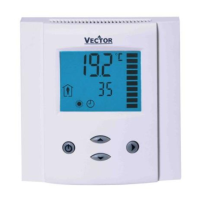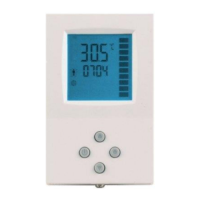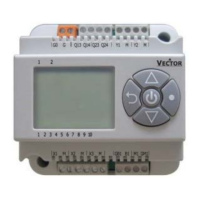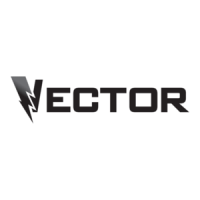TCY3-T1102 Engineering Manual
Doc: 70-000003 V1.0, 20150710 © Vector Controls GmbH, Switzerland Page 12
Subject to alteration
PID-control
Each loop has two PID sequences, one reverse and one direct acting. The adjustment of the sequence is done by selecting
the proportional band.
Legend:
T, U Input signal
X
PH
P-band heating, direct
X
PC
P-band cooling, reverse
X
DZ
Dead zone
X
SBY
Standby set point shift
W
H
Set point heating, reverse
W
C
Set point cooling, direct
Y
H1,
Y
R1
P sequence heating, reverse
Y
C1,
Y
D1
P sequence cooling, direct
Proportional control:
Proportional-band X
P
: Definition: The change in measured value required to give a 100% change in output. Setting this
parameter to 0 disables the P-part of the respective sequence.
Integral & differential control:
Function: At the interval of T
I
the integral is added or subtracted by the error ΔW (difference of the measured value to
the set point) multiplied with factor K
I
. T
I
and K
I
define the integral action Time (IAT). IAT is the time it takes for the
integral action to equal the proportional action. The values required for T
I
and K
I
depend on the reaction time of the
control loop. If the integral action time (IAT) is chosen too short or K
I
too large, the control loop will become instable and
oscillate. With a delta of 1° for temperature loops or 1% for universal loops, a KI of 1.0 and an interval of 1s, it will take
100 seconds for the integral to rise from 0 to 100% (reset time = 100s).
Integral Action Time:
T
I
: Interval time: T
I
is the period in seconds or minutes after which the integral is added or subtracted. A large interval
time will increase the action time and a short interval with decrease it.
K
I
: I-Gain: Multiplication factor for the growth rate of the integral. A small number will slow down the action time while a
larger number will speed up the integral action time.
Recommended values for heating systems: TI = 3s, KI = 1.0, integral action time = 300 sec.
Recommended values for cooling systems: TI = 3s, KI = 1.2, integral action time = 250 sec.
2-pipe or 4-pipe systems: 2-pipe systems use the same infrastructure for heating and cooling. Heating and cooling
mode needs to be changed externally according to season. 4-pipe systems consist of individual heating and cooling
equipment and are therefore able to supply heating and cooling simultaneously according to demand.
VAV function: The cooling output is increased parallel to the heating output but limited to a maximum value while
heating is active. This is used in VAV systems to supply fresh air in the heating season.
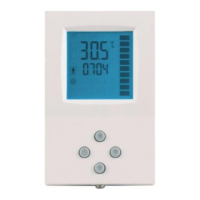
